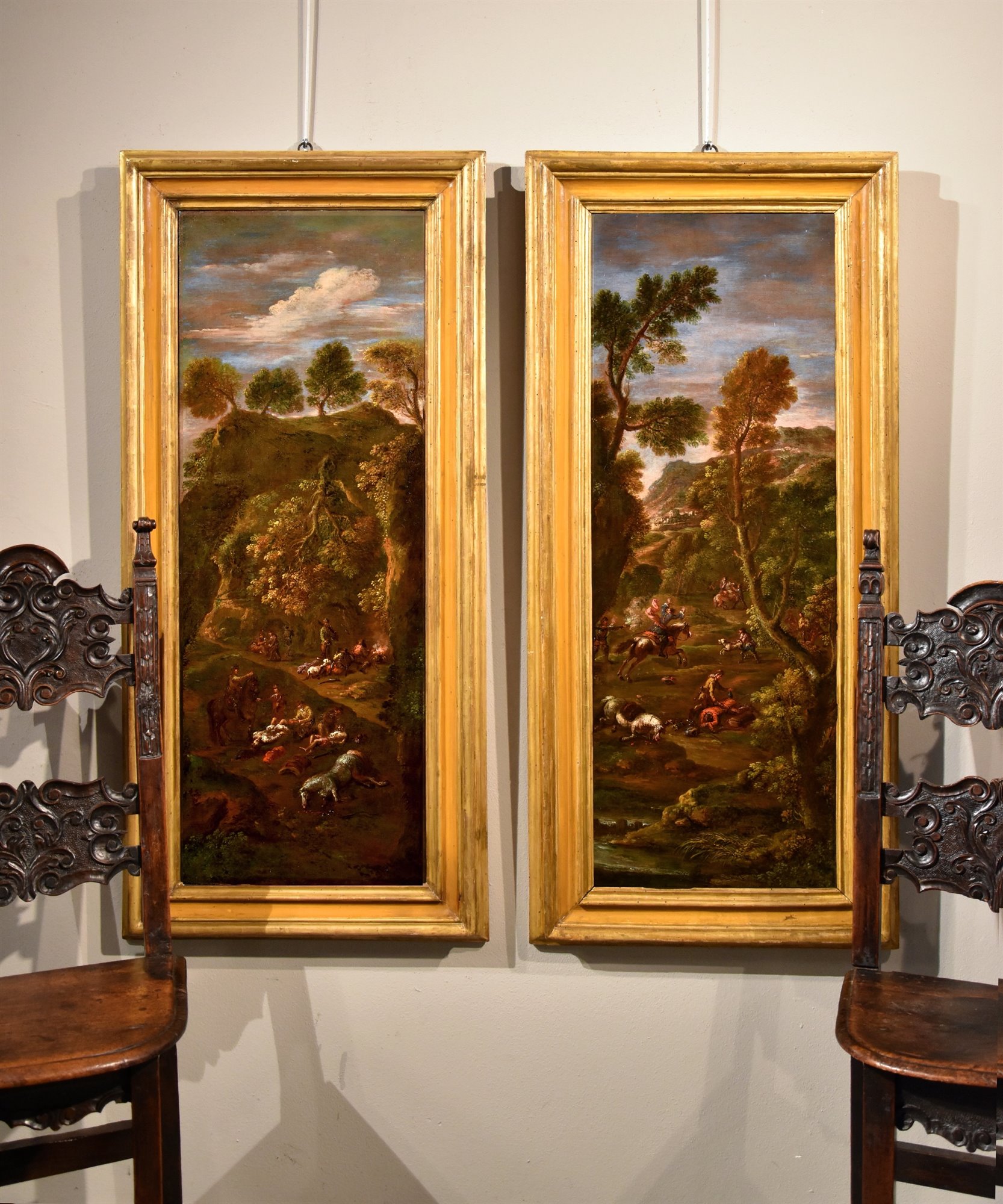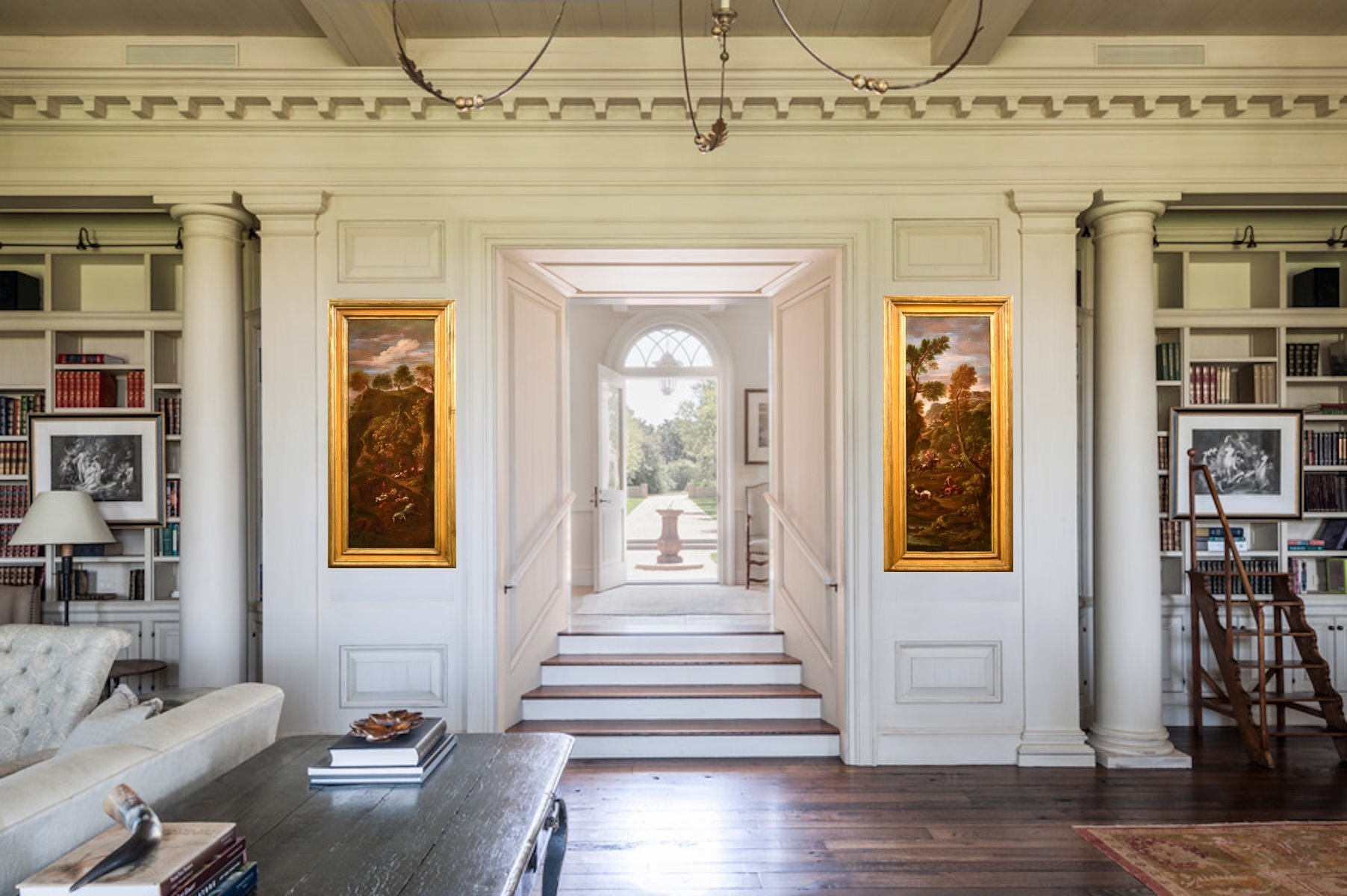Giuseppe Zais (Canale d’ Agordo 1709 - Treviso 1781)
Pendant di dipinti - L'assalto dei briganti/Dopo l’assalto
Giuseppe Zais
(Canale d'Agordo, Belluno 1709 - Treviso 1781)
(Canale d'Agordo, Belluno 1709 - Treviso 1781)
Pendant of paintings
The assault of the brigands
After the assault
Oil on canvas, 108 x 42 cm. each
In frame 128 x 62 cm.
We are grateful to Doctor Federica Spadotto for having studied this pendant of paintings and brought it back to the catalog of Giuseppe Zais.
Below we propose the in-depth critical study.
The Venetian landscape of the golden century has now accustomed the public and scholars to extraordinary - as well as unexpected - contaminations between genres, sealing an artistic stage that is very permeable to international influences. This happens, without a doubt, by virtue of the "forest" origin linked to the rural repertoire, which records the fundamental contribution of the references from beyond the Alps (Spadotto, 2014) with regard to the inspiration and the expressive alphabet of indigenous artists.
Among the latter, the experience of Giuseppe Zais (Canale d'Agordo 1709 - Treviso 1781), an Agordino painter who emigrated to the city of the lion, probably between the thirties and forties of the seventeenth century, is fundamental, where he would have conducted his apprenticeship (Moschini) at the battalist Francesco Simonini (Parma, 1686- Venice or Florence, post 1755). It was, in fact, a common practice for any painter who aspired to an official role - that is, enrollment in the Fraglia - to practice alongside an established character, such as the Parma master. More than a real apprenticeship, it is necessary to imagine the young painter active as an apprentice grappling with the warlike themes that had made Simonini famous in the Lagoon, where orders flooded with the consequent need to entrust part of the work to a valid help (i.e. to our Joseph).
Only recently, or thanks to the pictorial essays made known by Egidio Martini, has a nucleus of paintings made by Giuseppe been identified (fig. 1) on strict adherence to his master's repertoire and which for a long time had been believed to be Simoninian autographs.
The analysis of these specimens highlights close affinities of form and style with respect to the counterparts of Francis, on which the Zais inserts some guiding characters that will become typical of his manner, among which the round tower and the characteristic physiognomy of the faces stands out. .
Over the years, our artist will archive this experience in favor of the sunny afternoons of Zuccarellian inspiration, as well as collaborating with his son Gaetano (documented between 1765 and 1798) in his chosen genre. And precisely a landscape created by the latter and made known by the writer (Spadotto, op.cit., 2014, fig. 284, plate XLV; fig. 2) offers an important documentary piece to shed light on the extreme creative season of Ours, passed over in silence from the sources and devoid of autograph works.
In the Landscape conceived with figures, statues and animals at the watering point (fig. 2) the Zais junior hands down a compendium of his father's production, expressed through a rather dense ductus and a chromatic range played on "earthy" tones, in harmony with the riccesco revival (Marco Ricci; Belluno, 1676-Venice, 1730) very popular in the second half of the 18th century. Moreover, Zuccarelli himself (Pitigliano, 1702-Florence, 1788) had yielded to the seduction of Belluno, creating the Hunt for the bull (fig. 3) now at the Gallerie dell 'Accademia in Venice, a true exemplum with respect to the theme, where the same pictorial ingredients mentioned above emerge.
The remarkable pendant object of examination fits into this horizon, which "scans" like a real testament the long artistic career of Joseph, from his beginnings as a specialist in battles to the extreme synthesis of the late eighteenth century.
Simonini's soldiers become knights at the mercy of an attack by brigands, who kill them and strip them of all possessions, as happens in After the assault, in which the compositional system of the post-battle camp hosts the outcome of the fatal crime, perpetrated by characters in whom we recognize the clothes and the phosonomy of the villagers immortalized by Giuseppe in the famous rural passages.
The taste for detail, of clear Zuccarellian ancestry, blends with a fast, immediate style, which does not betray, however, the definition of the foliage in the typical, large trees called to frame the scenes, where the inspiration of the aforementioned Ricci blends with the Northern European "fashion" which was prevalent in Venetian figurative culture in the late 18th century.
In spite of what the public's taste expressed for most of the golden century, electing the languid Arcadian poetry as the territory of its aesthetic ideals, the decline of the Serenissima brings back the echoes of that "stepmother nature" frequented by the first generation of landscape artists, which returns, very current, as a metaphor for a world destined to die out a few years after (1797) the artist's death.
Ulteriori informazioni su questo testo di originePer avere ulteriori informazioni sulla traduzione è necessario il testo di origine



